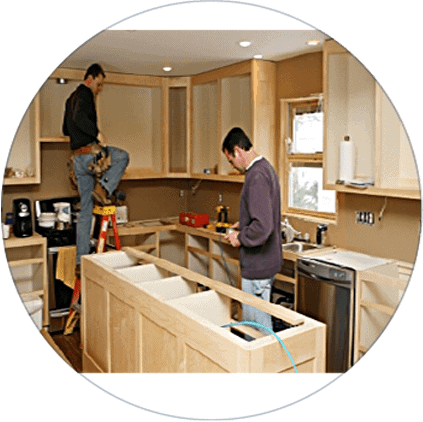Knowing what you want and writing it out
Before the first nail is hammered in and coat of paint is applied, it is important to have a good start. Just like a building, an idea needs a good foundation to build from. First start by making a list of what you need and what is most important to you. Ask yourself:
What do I need my kitchen to do for me?
Do I need new appliances?
Do I need new cabinetry?
Do I need new flooring?
When you start to break things down into lists, it allows you to stay focused which helps keep you on budget. It also helps you set priorities for your design and décor. Do you need little extras like moldings and the most innovative faucets and sinks? Decorative hardware and fixtures can add up quickly, so it is a good idea to keep your running lists and stay within your perimeters to stay on budget.
Find your budget…and stick to it!
Setting your budget can be a stressful thing. On paper, it can seem easy but when you start to really get into it, you will see the challenges. With the average cost of a kitchen remodel being approximately $80,000, you can start to feel your head spin and your blood pressure rise. There are three factors that will determine if you are willing to go that distance:
- How much can you afford to spend?
- How long do you plan to stay in your home?
- Will what you put into the remodel pay off when you go to sell your home?
Look at things like your “realistic” monthly income to see what you can afford to spend. If you are looking to stay in your home until the kids are out, then you want to make sure the remodel is cost effective and perfect for your everyday life. If you are looking to flip your home within five years, then you can apply the cost of the remodel to your selling price and consider it an upgrade to improve traffic for potential buyers.
How will you pay for this remodel?
There are several ways to pay for a remodel. Depending on the contracting company, you may be able to use their line of credit or payment plan to initiate the remodel. There are a number of home equity loans out there as well. This is typically the way that most homeowners pay for improvements as they are tax deductible and easier to manage financially. Refinancing and personal loans against retirement plans and life insurance are ways to do this, though they can be more risky to you should your financial situation change or if the market changes. Make sure to really plan ahead when borrowing money. Most contractors require upfront payments, and the longer it takes to get money, the longer you have to wait for your new kitchen.
Breaking down the costs
There is a simple and standard cost matrix for most remodels. Labor will typically consume about 20-35% of your overall costs. Check out the cost matrix for an average remodel:
- 35 percent: cabinets
- 20 percent: labor
- 20 percent: appliances
- 10 percent windows
- 5 percent: fixtures
- 3 percent: fittings
- 7 percent: other
This goes back to tip #1. Make sure to constantly reference your reasons and needs when planning a remodel. By sticking to those lists and the matrix, you are better able to stay on track.
Always set aside some $$ for the unknown
In a perfect world, things go as planned…but we all know it never works out that way. With any kind of construction project, you are bound to encounter some twists and turns. This can be a definite when working with older homes or in areas that have very strict zoning laws. It is always a good idea to reserve about 20% of your overall budget for these types of emergencies. You may encounter mold or water damage once things are pulled out. You may have to get an unexpected permit to add a feature, or you may have to get an upgraded appliance to fit the space or the need. Whatever the reason, giving yourself that financial cushion will be a money saver at the end of the day.
Have you met your good friend, The Spreadsheet?
Lists are great, but spreadsheets are where it’s at for listing your budget and costs. It allows you to step back and take a good look at where your time and money is really going. It helps you keep tabs on your spending, the contractor’s spending and how it is flowing and jiving with the budget you have created for yourself. Remember: never put all your faith into this will be done without you watching….always keep an eye on your remodel.
Should you stay or should you go during a remodel?
Depending on your home’s configuration, staying during a remodel can be simple or a downright disaster. While living outside of your home while the work is being done is generally less stressful, some people don’t want to leave their home in fear of missing out as well as the added cost from staying in a hotel or temporary living space. Always consider the costs of a temporary home and if it is imperative to not be in your home during the remodel, remember to factor this into your overall budget. Many contractors will offer tips on how to create a temporary kitchen. Also look to family and friends to see if they can let you “crash” in on a few dinners and lunches.
Going out for meals
More than likely you will need to eat out for some meals during the process. Whether you grab some take-out or head out to your favorite restaurant, make sure to factor this into your overall budget. This is where you can run into some financial issues. We tend to forget about the real costs of eating out. These tend to be costs we put in the back of our minds and think we’ll notate later. Then a few weeks later when you look at your account you realize just how much you have spent.
Do some of the smaller things yourself
Smaller improvements like décor, trims and material removal can actually be done by you! Once you know your kitchen’s plan, you can start to remove the old fixtures and cabinetry yourself to save time and money that the contractor may charge. Make sure you have a plan and are removing the right materials, and go for it! Décor and trims can also be done by you once the main portion of your kitchen is installed. Remember, this is your remodel…so make it your own!
Try to avoid the temptations of extras!
You saw your neighbor’s new fancy-shmancy fridge and now you have to have one too! Stop right there! Go back to tips #1, 5 & 6! Stay on point and stay focused. This is exactly how a budget can be blown up. While those fun extras and upgrades seem so nice and easy, they can add up really fast. If you really need them, rework your budget and keep everything in check so that you can make room for that little extra goodie.





